| The Very Highest Quality Halfpennies... |
| The Story of the Halfpenny |
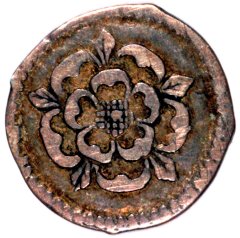
|

|
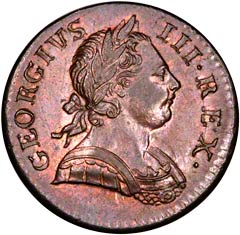
|
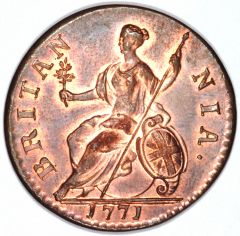
|
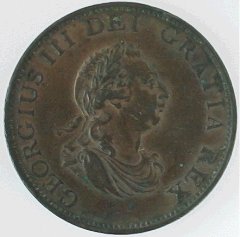
|
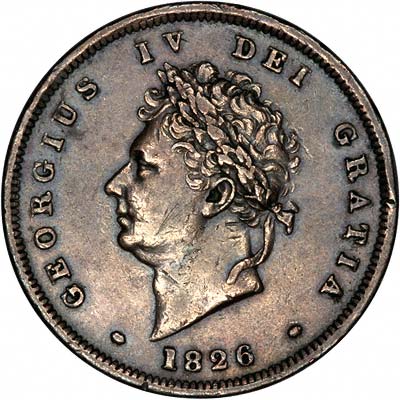
|
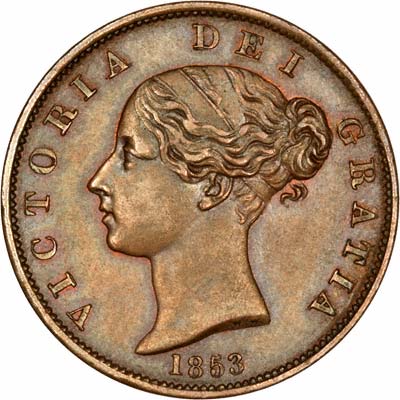
|
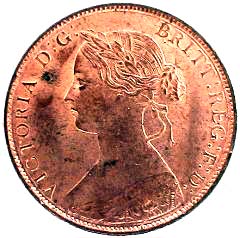
|

|
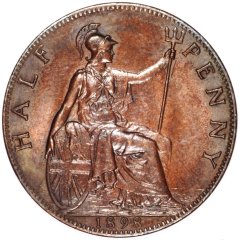
|
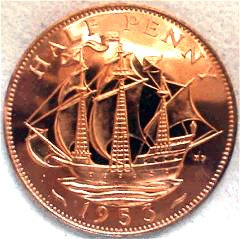
|
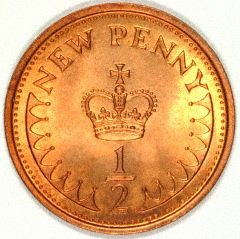
|
Half A Penny
The first halfpennies were literally pennies cut in half. For several centuries, silver pennies were the only coins produced.
Ceolwolf
It was thought until recently (2005), that the earliest British halfpenny was for Alfred the Great, but in 2004/5, a slightly earlier specimen was found for Coelwolf, 875 to 880. So far only one example is known.
Alfred the Great
In about 886 AD, during the reign of King Alfred the Great, round silver halfpennies were struck, for the second known time. Examples are quite scarce, and it was therefore not thought to have been produced in large quantities.
Imitation Is The Sincerest Form Of Flattery
It was obviously a popular coin because many imitations were produced in the "Danelaw", the Danish held North-East of England. These were all copies of the halfpence of Alfred. These first halfpennies bear a portrait of Alfred on the obverse, with a monogram of the word LONDINIA on the reverse, similar to a silver penny of the same period, but smaller.
Before this time, it had been the practice to cut pennies into two halves, or four quarters, to provide small change.
Round halfpence continued to be produced in the following reigns of Edward the Elder, Aethelstan, Eadmund, Eadred, Eadwig, and Eadgar, although all are much rarer than their equivalent pennies, and many are unique.
Cost Factor
One persistent problem with the production of halfpence was that the cost of production was almost the same as for pennies, so that it was uneconomic to produce halfpence in large quantities. No further halfpence were issued after the end of Eadgar's reign in 975 AD until 1108 during the reign of Henry I, and even this is very rare. Several reigns then passed, King John issued silver halfpence for Ireland, and in his own name, but not for England where all the silver pennies issued retained Henry's (II) name.
Production Restarts under Edward I
Not until after 1279, in the reign of Edward I, were halfpennies again produced. This time they were obviously produced in large quantities as they are still relatively plentiful today, and about a dozen different varieties are known. At the time, one penny would have been a full day's pay, or the price of a sheep, so it is clear that there would have been a demand for lower denomination coins. From that time onwards, halfpennies were issued regularly during most reigns, up to and including the Commonwealth under Oliver Cromwell, but usually in smaller quantities than pennies.
Copper and Tin
In the reign of Charles II in 1672, copper halfpennies were issued for the first time. The reign of James II continued similarly. Under William and Mary, tin halfpennies were produced between 1690 and 1694, and copper halfpennies in 1694. Halfpennies continued to be produced for William III after Mary's death.
A Shortage of Small Change
Few halfpennies were then struck for much of the 18th century. Small "dump" issues were produce for George I in 1717 and 1718, on a small diameter, thick flan, followed by a more normal issue from 1719 to 1724. There were no halfpennies produced during the reign of Queen Anne, and the next halfpennies, for George III, were not produced until 1770 to 1775. A large number of poor quality counterfeit copies of this issue turn up, and it is clear from this evidence that halfpennies must have been in very short supply and great demand. The copies were obviously accepted in change almost as readily as the genuine articles.
Steam Engines
Large copper halfpennies were produced under contract by Matthew Boulton and James Watt's Soho mint in Birmingham, using steam powered machinery to drive very heavy duty coining presses with great efficiency, although after the great revision of the coinage in 1816, no further halfpennies were then struck for George III.
The next halfpennies were dated 1825 to 1827 for George IV, and 1831, 1834, and 1837 for William IV.
Under Queen Victoria, copper pennies were produced in almost every year from 1838 to 1860 inclusive.
From Copper to Bronze
In 1860 the base metal coinage was changed to a smaller, lighter, bronze issue, although to this day, most bronze coins are referred to as being copper, and individual examples are called "coppers", even when they have now been replaced by copper-plated steel. the new bronze halfpennies continued in production until 1967, or possibly later but dated 1967.
The halfpenny was demonetised and withdrawn in August 1969.
Decimalisation and the End Of The Line
The spirit of the halfpenny lingered on for a few more years in the form of the "half new penny" issued from 1971 to 1981. Strangely enough, although all the other denominations during this period were called "... new pence", the new halfpenny, or half new penny, continued to be inscribed as "half penny" Although the half new penny survived the change back from "new pence" to "pence" in 1982, it was soon considered irrelevant, and was last produced for circulation in 1983, although halfpennies dated 1984 were issued as part of mint and proof sets issued for collectors.
The half new penny was demonetised in December 1984.
Designs
Silver
Small Pennies
The design types of most of the silver halfpennies closely followed those of their respective penny issues, except that they were smaller. In many cases the inscriptions would be slightly abbreviated because of the smaller space available, and often the workmanship would be slightly cruder, or finer details of the design would be omitted. This applies to most denominations in any case; larger, more valuable denominations would be produced with more care and attention to detail.
Portcullis
During the reign of Elizabeth I, a different design was introduced for the halfpennies, a portcullis on the obverse, and a cross with pellets (raised dots) in the angles on the reverse.
Roses, Thistles & Plumes
The portcullis design was continued for the first coinage of James I, but was replaced by a rose on the obverse, and a thistle on the reverse. Under Charles I halfpennies were produced with a rose on both sides and no inscriptions, later a plume of feathers was used on the reverse in place of the rose.
Commonwealth 1649 - 1660
During the commonwealth period, the types were changed for all denominations, and the halfpennies were of a similar design to the rest, which was a shield bearing St. George's cross on the obverse, and conjoined shields of the reverse, one bearing St. George's cross, the other an Irish harp. This was the last silver halfpenny issued.
Copper
The large copper halfpennies issued for Charles II, from 1672 to 1675, bore a portrait of the king facing left, and their reverse type was a figure of Britannia seated left, holding a spear and olive branch. A shield bearing the Union Flag leans against the seat. This closely mirrors similar designs used on Roman coins alluding to Britain issued by Antoninus Pius, 138 to 161 AD, and also by other Roman emperors.
At the same time, farthings were also issued with a similar figure of Britannia, but not as well engraved.
Tin
Tin was first used to replace the copper farthings of Charles II, but no halfpennies were produced in tin.
The tin halfpennies produced for James II featured a continuation of the Britannia design, and were made with a copper plug in the centre of the coin. Both tin and copper versions were made for William and Mary, but from the sole reign of William III onwards only copper versions were produced.
Bronze
Britannia remained the only reverse type for the copper halfpenny, even after it was replaced by the smaller bronze halfpenny in 1860, and continued until 1936, the last year of George V's coins, although the details of the design evolved slightly as time passed, so that by the large copper issues of George from 1799 onwards, Britannia is shown seated on a rock, apparently an island, holding a trident, with a ship and seascape background. The ship then disappears, until the bronze issues. From 1860 to 1894 a lighthouse also made a guest appearance on the young head Victoria coins.
Eventually, Britannia was retired from the halfpenny after 1936, and was replaced by a three masted ship, Drake's Golden Hind, from 1937 to 1967.
Decimalisation
The last "old" halfpenny minted for circulation was 1967, although 1970 halfpennies were issued in "Farewell" proof sets of that year. Halfpennies were demonetised on August 1st. 1969.
The coin minted from 1971 to 1981 was not a halfpenny but a "half new penny", its reverse design being a crowned 1/2, with the lettering "new penny" above.
In 1982, all the decimal coins were re-designated as pennies rather than new pennies, and the halfpenny design was modified accordingly, in that the lettering was changed to read "half penny". After 1984, the halfpenny was phased out of production.
The halfpenny had existed for over 1000 years, and only failed by two years to notch up its eleventh century.
Pence or Pennies?
Although the plural of penny is pence, the word pennies can also be used. In the case of the halfpenny, both versions of the plural, that is halfpence and halfpennies seem equally acceptable. It is not possible, of course, to have one halfpence, just as it is not correct to say one pence. If you possessed more than one halfpenny, you would have a number of halfpennies, and if you owned two pennies and one halfpenny, you would call it two and a half pence.
The Story of Britannia on British Coins
If you want to find the value of a coin you own, please take a look at our page I've Found An Old Coin, What's It Worth?
If you have an enquiry about any of our Halfpennies, we'd be happy to answer you, but please note it may be quicker to telephone us. Please see the Contact Us page of our website.
| ...at the Lowest Possible Price |
|
32 - 36 Harrowside, Blackpool, Lancashire, FY4 1RJ, England. Telephone (44) - (0) 1253 - 343081 ; Fax 408058; E-mail: The URL for our main page is: https://24carat.co.uk | Chard(1964) Ltd |